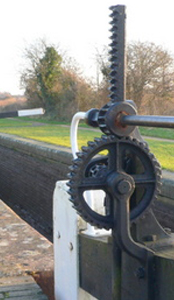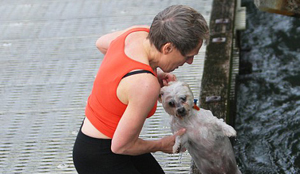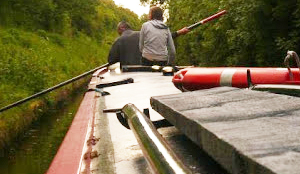Narrowboat safety – or indeed boat safety of any kind – is largely a case of using common sense. However, watch a crew of any boat for long enough, and certain bad habits start to creep in, particularly in the less obvious areas of boating. We are all guilty, myself included, so it does no harm to remind ourselves of what should be regarded as best practice.
First, let’s start on the side of the canal. When preparing a lock for a boat, make sure that the boat is either securely tied to a bollard, or the steerer on board has full control of the vessel. Many narrowboaters have seen their expensive investment drifting out of control because they underestimated the strength of the water flow as a lock fills or empties.
Next – and this applies to those of us who are blessed with lustrous and flowing locks of hair – ensure that when you bend over lock winding gear, your hair does not become entangled in the ratchet mechanism.

Again, this may sound obvious (or you may feel this is unlikely to happen) but I have seen it myself and in many cases the only rapid solution is to cut the hair away…..
The same degree of caution should apply to your clothing. Loose coats or waterproofs are very easy to get snagged in winding gear or when crossing lock gates. Try and ensure they are not flapping about – keep them zipped or buttoned up.
Those of us who have dogs should make sure they are inside the vessel and NOT running about on the back deck. Many boaters feel that provided the dog is tied onto the back of the boat they are safe. Remember – if a lead is long enough for the dog to move about freely, it is probably long enough for them to fall off the side of boat!

If you are walking along the towpath and taking your dog with you, make sure they are under control, that they don’t get in your way when negotiating locks and that you only get them back on the boat when it is safe to do so. I have seen people trying to hold a boat in a strong wind with a frantic dog trying to jump back on board. This is clearly dangerous and could end in tragedy.
When tying up and mooring, make sure your mooring ropes do NOT cross the towpath, and that your mooring pins are clearly marked with a bright rag or other item to alert walkers and cyclists.
At some stage in your cruising career, you WILL run aground. It is almost inevitable as canals either silt up or water levels drain away from some moorings overnight, and knowing what to do in advance is invaluable. If you run aground when moving, putting the boat into reverse and backing away from the shallow water may be enough. Do NOT try and blast yourself over the obstacle with full throttle. The chances are you will simply force the boat into shallower water.

All narrowboats should carry a long barge pole to be used to push the boat away from the obstruction – and there is a correct way to use it. NEVER use it to try and lever the boat away as it could snap and tip the user into the water. Instead, get the pole under one arm; stand on the opposite side of the boat from the obstruction so your weight assists on tipping the boat off and push smoothly.
If you are a continuous cruiser or are living on a narrowboat, the chances are you will have a load of loose items inside the boat. Even hire boats will have a collection of breakable crockery etc about. Where possible, try and ensure loose items are secured inside cupboards. Turbulence when filling a lock can make a 15 ton narrowboat move around alarmingly and a collision against a lock wall can cause a surprising amount of damage to delicate items.
These are just a few tips for the more unusual incidents that can occur on the canal network of the UK – canal cruising is largely safe for all the family and will continue to be so – as long as a little thought is given to basic rules. If YOU have any tips you wish to pass onto other boaters – include them on the ‘Comment’ section at the bottom of this page.

Excellent tips! Some seem obvious but it’s a good idea to remind ourselves frequently.
Advice about dogs is particularly good. we’ve only lived on Puddleduck for a year but I’ve seen some canal users of all types take some completely unnecessary and daft risks.
Today one of ours was playing on the tow path and in her enthusiasm fell about eight feet into a lock and it took me a while to recover her. Nasty shock for both of us. Dogs are made for boats and canals are fabulous places for them to live but we must be vigilant.
Thanks for the article
One very good tip I was given, and now always give to others, is that when crossing from boat to shore or the other way, think to yourself “I could fall in here!” And that way you’re unlikely to do so. It’s still working for me! 😉
Think I’ll stick to the Norfolk Broads
Some very good points made here – thanks for sharing!
Also be wary of other people’s dogs running about. A friend of mine was at Hurleston Locks last week when a dog walker appeared with 2 dogs running free. One cross the lock gate then turned to go back meeting the other dog on the gate. As expected one dog fell in and was then sucked into the filling lock through the paddle. When it appeared the owner then jumped into the lock and both he and the dog had to be recovered. Thankfully they didn’t shut the paddle while the dog was under water as this may have injured the dog. Always be ready for the unexpected.